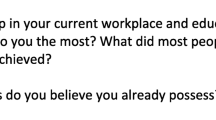Abstract
This study examined the perceptions and concerns of current academic department chairs as they consider the transition to full responsibilities as a faculty member after the completion of a term in this leadership role. Currently, little research has focused on the dynamics of this transition process. Findings indicated that most department chairs planned to return to faculty positions and that a primary concern was reconstructing research agendas with minimal support. The discussion proposes ways in which institutions can support the return of former chairs to a faculty position that demands and rewards achievement in teaching, research, and service. These findings have implications for influencing policies and procedures relative to securing and continuing quality leadership and faculty productivity at the departmental level.
Similar content being viewed by others
Notes
Department chair is used throughout the article to refer to both chairs and heads of departments.
References
Aggarwal, P., Rochford, L., & Vaidyanathan, R. (2009). The hot seat: Profiling the marketing department chair. Journal of Marketing Education, 31(1), 40–51.
Ashforth, B. E. (2000). Role transitions in organizational life: An identity-based perspective. Mahwah, NJ: Lawrence Erlbaum.
Aziz, S., Mullins, M. E., Balzer, W. K., Grauer, E., Burnfield, J. L., Lodata, M. A., et al. (2005). Understanding the training needs of department chairs. Studies in Higher Education, 30(5), 571–593. doi:10.1080/03075070500249260
Bowman, R. F. (2002). The real work of department chair. The Clearing House, 75(3), 158–162.
Butler, J. (2008). The essential department chair: A practical guide to college administration. Boston, MA: Anker.
Carnegie Foundation (2009). Carnegie very high research activity institution classifications. Retrieved from http://classifications.carnegiefoundation.org/lookup_listings/srp.php?clq={%22basic2005_ids%22%3A%2215%22}&limit=0,50
Cartwright, D. (Ed.). (1951). Field theory in social science: Selected theoretical papers. New York, NY: Harper & Brothers.
Chu, D. (2002). The return of the native: Department chair returns to the faculty. Academic Leader, 18(2), 7–8.
Chu, D. (2003). Why do department chairs decide they’ve had enough? Academic Leader, 19(9), 2–3.
Danielson, L., & Schulte, L. (2007). Voices of women in the field: The top 10 things we learned about being a department chair. Journal of Women in Educational Leadership, 5(1), 77–81.
Foster, B. L. (2006). From faculty to administrator: Like going to a new planet. In R. J. Henry (Ed.), New directions for higher education: Summer 2006. Transitions. between faculty and administrative careers (pp. 49–57). doi:10.1002/he.216
Gmelch, W. H., & Burns, J. S. (1993). The cost of academic leadership: Department chair stress. Innovative Higher Education, 17(4), 259–270.
Gmelch, W. H., & Parkay, F. W. (1999, April). Becoming a department chair: Negotiating the transition from scholar to administrator. Paper presented at the Annual Meeting of the American Educational Research Association, Montreal, Ontario, Canada.
Mills, R. (2006). Leadership in higher education and the second half of life. Education, 127(2), 294–302.
Palm, R. (2006). Perspectives from the dark side: The career transition from faculty to administrator. In R. J. Henry (Ed.), New directions for higher education: Summer 2006. Transitions between faculty and administrative careers (pp. 59–65). doi:10.1002/he.216
Perakyla, A. (2005). Analyzing talk and text. In N. K. Denzin & Y. S. Lincoln (Eds.), The Sage handbook of qualitative research (3rd ed., pp. 869–886). Thousand Oaks, CA: Sage.
Qualtrics Labs, Inc. (2009). Employee exit interviews [Increasing employee retention through employee exit interviews]. Retrieved from http://qualtrics.com/university/employee-exit-interviews/
Seedorf, R. G. (1991, April). The transition of the university department chair: What must be left behind? Paper presented at the Annual Convention of the American Educational Research Association, Chicago, IL.
Tichy, N. M. (1997). The leadership engine: How winning companies build leaders at every level. New York, NY: HarperCollins.
Wilson, R. (2001, March 2). Beggar, psychologist, mediator, maiden: The thankless job of a chairman. The Chronicle of Higher Education. Retrieved from http://chronicle.com
Wolverton, M., & Ackerman, R. (2006). Cultivating possibilities: Prospective department chair professional development and why it matters. Planning for Higher Education, 34(4), 14–23.
Author information
Authors and Affiliations
Corresponding authors
Rights and permissions
About this article
Cite this article
Smith, D.L., Rollins, K.B. & Smith, L.J. Back to the Faculty: Transition from University Department Leadership. Innov High Educ 37, 53–63 (2012). https://doi.org/10.1007/s10755-011-9186-8
Published:
Issue Date:
DOI: https://doi.org/10.1007/s10755-011-9186-8




